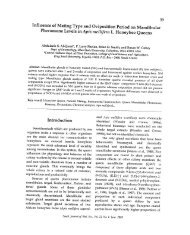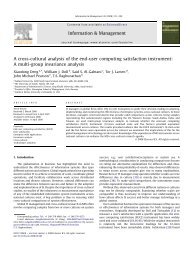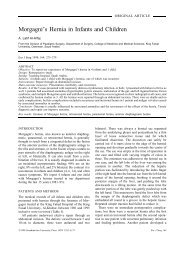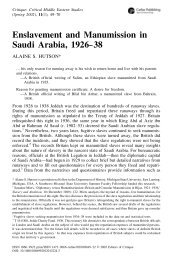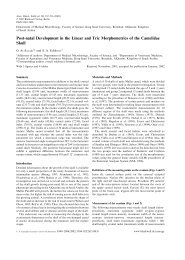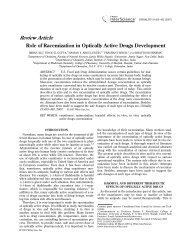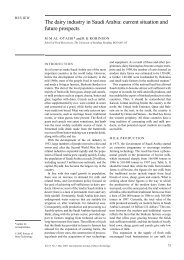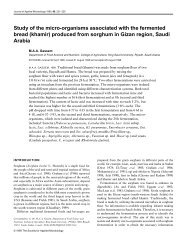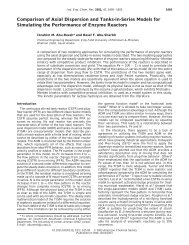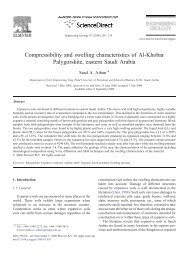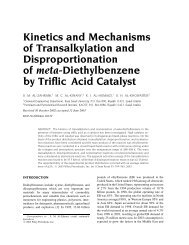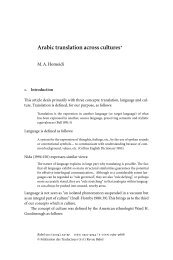The Influence of Alumina on the Performance of FCC Catalysts ...
The Influence of Alumina on the Performance of FCC Catalysts ...
The Influence of Alumina on the Performance of FCC Catalysts ...
You also want an ePaper? Increase the reach of your titles
YUMPU automatically turns print PDFs into web optimized ePapers that Google loves.
62 Energy & Fuels 2003, 17, 62-68<br />
<str<strong>on</strong>g>The</str<strong>on</strong>g> <str<strong>on</strong>g>Influence</str<strong>on</strong>g> <str<strong>on</strong>g>of</str<strong>on</strong>g> <str<strong>on</strong>g>Alumina</str<strong>on</strong>g> <strong>on</strong> <strong>the</strong> <strong>Performance</strong> <str<strong>on</strong>g>of</str<strong>on</strong>g> <strong>FCC</strong><br />
<strong>Catalysts</strong> during Hydrotreated VGO Catalytic Cracking<br />
S. Al-Khattaf †<br />
Chemical Engineering Department, King Fahd University <str<strong>on</strong>g>of</str<strong>on</strong>g> Petroleum & Minerals,<br />
Dhahran, 31261 Saudi Arabia<br />
Received March 13, 2002<br />
Two categories <str<strong>on</strong>g>of</str<strong>on</strong>g> <strong>FCC</strong> catalysts were prepared. <str<strong>on</strong>g>The</str<strong>on</strong>g> first <strong>on</strong>e is an <strong>FCC</strong> catalyst c<strong>on</strong>taining<br />
Y-zeolite and amorphous matrix. <str<strong>on</strong>g>The</str<strong>on</strong>g> sec<strong>on</strong>d category is amorphous catalyst without Y-zeolite.<br />
<str<strong>on</strong>g>Alumina</str<strong>on</strong>g> was systematically added to both catalyst categories. <str<strong>on</strong>g>The</str<strong>on</strong>g> additi<strong>on</strong> <str<strong>on</strong>g>of</str<strong>on</strong>g> alumina to <strong>the</strong><br />
<strong>FCC</strong> catalyst c<strong>on</strong>taining Y-zeolite forms an active matrix. <str<strong>on</strong>g>The</str<strong>on</strong>g> inactive matrix <str<strong>on</strong>g>of</str<strong>on</strong>g> <strong>the</strong> catalyst is<br />
composed <str<strong>on</strong>g>of</str<strong>on</strong>g> kaolin filler and silica sol binder. <str<strong>on</strong>g>The</str<strong>on</strong>g> experimental data clearly show that alumina<br />
additi<strong>on</strong> to both catalyst categories substantially increased both catalyst surface area and acidity.<br />
<str<strong>on</strong>g>The</str<strong>on</strong>g> additi<strong>on</strong> <str<strong>on</strong>g>of</str<strong>on</strong>g> alumina to <strong>the</strong> amorphous catalyst resulted in a significant increase in<br />
hydrotreated VGO c<strong>on</strong>versi<strong>on</strong>. However, similar alumina additi<strong>on</strong> to Y-zeolite c<strong>on</strong>taining<br />
catalysts did not appear to have a significant effect <strong>on</strong> <strong>the</strong> hydrotreated VGO c<strong>on</strong>versi<strong>on</strong>.<br />
1. Introducti<strong>on</strong><br />
Commercial <strong>FCC</strong> catalysts are manufactured using<br />
1-2-µm zeolites dispersed <strong>on</strong> an amorphous matrix<br />
forming 60-µm particles. 1,2 Zeolites are extremely active<br />
and provide catalyst activity, selectivity, and stability. 3<br />
<str<strong>on</strong>g>The</str<strong>on</strong>g>ir regular pore dimensi<strong>on</strong>s make <strong>the</strong>m selective as<br />
to which molecules are adsorbed or c<strong>on</strong>verted. Hence,<br />
Y-zeolite is <strong>the</strong> active and <strong>the</strong> most important comp<strong>on</strong>ent<br />
in <strong>FCC</strong> catalysts. Y-zeolite provides <strong>the</strong> major<br />
part <str<strong>on</strong>g>of</str<strong>on</strong>g> <strong>the</strong> surface area and <strong>the</strong> active sites. 1,2 Thus it<br />
is <strong>the</strong> key comp<strong>on</strong>ent, which c<strong>on</strong>trols catalyst activity<br />
and selectivity. 4-9 <str<strong>on</strong>g>The</str<strong>on</strong>g> catalytic activity <str<strong>on</strong>g>of</str<strong>on</strong>g> Y-zeolite is<br />
mainly c<strong>on</strong>trolled by its unit cell size (UCS) and to a<br />
lesser extent by its crystal size. Recently, Al-Khattaf and<br />
de Lasa have studied <strong>the</strong> effect <str<strong>on</strong>g>of</str<strong>on</strong>g> Y-zeolite crystal size<br />
<strong>on</strong> <strong>the</strong> activity and selectivity <str<strong>on</strong>g>of</str<strong>on</strong>g> <strong>FCC</strong> catalysts. 10-12<br />
Most commercial <strong>FCC</strong> catalysts c<strong>on</strong>tain between 15 and<br />
40 wt % zeolite. 2<br />
<str<strong>on</strong>g>The</str<strong>on</strong>g> activity and selectivity <str<strong>on</strong>g>of</str<strong>on</strong>g> <strong>FCC</strong> catalysts are<br />
mainly c<strong>on</strong>trolled via three processing strategies: 13<br />
† E-mail: skhattaf@kfupm.edu.sa. Ph<strong>on</strong>e: 9663-8601429. Fax: 9663-<br />
8604234.<br />
(1) Scherzer, J. In Fluid Catalytic Cracking: Science and Technology;<br />
Magee, J. S., Mitchell, M. M., Eds.; Elsevier: Amsterdam, 1993.<br />
(2) Humphries, D.; Harris, D.; O’C<strong>on</strong>nor, P. In Fluid Catalytic<br />
Cracking: Science and Technology; Magee, J. S., Mitchell, M. M., Eds.;<br />
Elsevier: Amsterdam, 1993; pp 41.<br />
(3) Humphries, A.; Wilcox, J. R. Oil Gas J. Feb 6, 1989.<br />
(4) Pine, L. A.; Maher, F. K.; Wachter, W. A. J. Catal. 1984, 85,<br />
466.<br />
(5) Arribas, J.; Corma, A.; Fornes, V.; Melo, F. J. Catal. 1987, 108,<br />
135.<br />
(6) Ino, T.; Al-Khattaf, S. Appl. Catal. 1996, 142, 5.<br />
(7) Al-Khattaf, S. Appl. Catal. 2002, 231, 293.<br />
(8) Rajagopalan, K.; Peters, A. W. J. Catal. 1987, 106, 410.<br />
(9) Ritter, R. E.;Creight<strong>on</strong>, J. E.; Roberies, T. G.; Chin, D. S.; Wear,<br />
C. C. NPRA Annual Meeting, Los Angeles, March 1986.<br />
(10) Al-Khattaf, S.; de Lasa, H. I. Ind. Eng. Chem. Res. 1999, 38,<br />
1350.<br />
(11) Al-Khattaf, S.; de Lasa, H. I. Can. J. Chem Eng. 2001, 3, 79,<br />
341.<br />
(12) Al-Khattaf, S.; de Lasa, H. I. Appl. Catal. 2002, 226, 139.<br />
zeolite characteristics such as silica/alumina ratio which<br />
is directly related to unit cell size, <strong>the</strong> presence <str<strong>on</strong>g>of</str<strong>on</strong>g><br />
additives such as ZSM-5, and <strong>the</strong> type <str<strong>on</strong>g>of</str<strong>on</strong>g> matrix in <strong>the</strong><br />
<strong>the</strong> <strong>FCC</strong> catalysts as <strong>the</strong> active matrix can c<strong>on</strong>tribute<br />
to <strong>the</strong> cracking reacti<strong>on</strong>s.<br />
<str<strong>on</strong>g>The</str<strong>on</strong>g> matrix comprises 60-85 wt % <str<strong>on</strong>g>of</str<strong>on</strong>g> <strong>the</strong> commercial<br />
<strong>FCC</strong> catalyst and usually c<strong>on</strong>tains syn<strong>the</strong>tic and natural<br />
comp<strong>on</strong>ents. Clay is <strong>the</strong> natural comp<strong>on</strong>ent and amorphous<br />
silica or silica-alumina is <strong>the</strong> syn<strong>the</strong>tic porti<strong>on</strong>. 14<br />
Matrix compositi<strong>on</strong> can influence catalyst performance<br />
but to a lesser extent than <strong>the</strong> zeolite comp<strong>on</strong>ent. 14 An<br />
inactive matrix does not c<strong>on</strong>tain enough str<strong>on</strong>g acid<br />
sites that can influence <strong>the</strong> catalyst performance. On<br />
<strong>the</strong> o<strong>the</strong>r hand, an active matrix c<strong>on</strong>tains acid sites<br />
associated with aluminum atoms (e.g., alumina). However,<br />
<strong>on</strong>ly those sites that have sufficient strength are<br />
able to c<strong>on</strong>tribute to <strong>the</strong> cracking reacti<strong>on</strong>s. 15 Am<strong>on</strong>g<br />
<strong>the</strong> different alumina available commercially, boehmite<br />
is <strong>the</strong> most important <strong>on</strong>e that is used in catalyst<br />
formulati<strong>on</strong>s. <str<strong>on</strong>g>The</str<strong>on</strong>g> high acidity <str<strong>on</strong>g>of</str<strong>on</strong>g> boehmite is <strong>the</strong> major<br />
reas<strong>on</strong> behind its catalytic activity. Its additi<strong>on</strong> to <strong>the</strong><br />
catalyst can improve <strong>the</strong> catalyst performance, improves<br />
attriti<strong>on</strong> resistance and serves as a metal trap. 1<br />
Active matrix is believed to improve bottoms upgrading<br />
and LCO quality by increasing <strong>the</strong> cetane number.<br />
1,15 <str<strong>on</strong>g>The</str<strong>on</strong>g> large pore <str<strong>on</strong>g>of</str<strong>on</strong>g> <strong>the</strong> matrix >500 Å facilitates<br />
large heavy oil molecule (10-100 Å) diffusi<strong>on</strong> and may<br />
cause cracking if <strong>the</strong> matrix c<strong>on</strong>tains acid sites with<br />
certain strength. <str<strong>on</strong>g>The</str<strong>on</strong>g> active matrix is characterized by<br />
high surface area and acidity. 1,15<br />
Usually active matrix enhances bottom c<strong>on</strong>versi<strong>on</strong><br />
and gasoline octane. 1,15-18 However, it also produces<br />
(13) Magee, J. S.; Letzsch, W. S. In Fluid Catalytic Cracking III;<br />
Materials and Processes; Occelli, M. L., O’C<strong>on</strong>nor, P., Eds.; American<br />
Chemical Society: Washingt<strong>on</strong>, DC, 1994.<br />
(14) Scherzer, J. In Fluid Catalytic Cracking III; Materials and<br />
Processes; Occelli, M. L., and O’C<strong>on</strong>nor, P., Eds.; American Chemical<br />
Society: Washingt<strong>on</strong>, DC, 1994.<br />
(15) Scherzer, J. Catal. Rev.-Sci. Eng. 1989, 31, 3, 215.<br />
10.1021/ef020066a CCC: $25.00 © 2003 American Chemical Society<br />
Published <strong>on</strong> Web 12/05/2002
<strong>Performance</strong> <str<strong>on</strong>g>of</str<strong>on</strong>g> <strong>FCC</strong> <strong>Catalysts</strong> Energy & Fuels, Vol. 17, No. 1, 2003 63<br />
more coke, dry gas, and less gasoline than inactive<br />
matrix. 16-18 <str<strong>on</strong>g>The</str<strong>on</strong>g> effect <str<strong>on</strong>g>of</str<strong>on</strong>g> alumina additi<strong>on</strong> to <strong>FCC</strong><br />
catalyst matrix <strong>on</strong> processing different kinds <str<strong>on</strong>g>of</str<strong>on</strong>g> VGO<br />
feedstock was studied by Otterstedt et al. 17 <str<strong>on</strong>g>The</str<strong>on</strong>g>y<br />
observed that alumina additi<strong>on</strong> to <strong>the</strong> catalyst matrix<br />
had increased <strong>the</strong> c<strong>on</strong>versi<strong>on</strong> <str<strong>on</strong>g>of</str<strong>on</strong>g> <strong>the</strong> heavier feed oil but<br />
at <strong>the</strong> same time increased coke selectivity and decreased<br />
gasoline selectivity. However, alumina additi<strong>on</strong><br />
did not have a significant effect during lighter feed oil<br />
processing. Coke and gasoline selectivities were found<br />
to have similar behavior to those <str<strong>on</strong>g>of</str<strong>on</strong>g> heavier feed oil.<br />
It has been reported that <strong>the</strong> olefin/paraffin ratio<br />
decreases by increasing zeolitic c<strong>on</strong>tent and decreasing<br />
matrix activity. 19 Moreover, Scherzer 15 claimed that<br />
increasing matrix activity (by adding alumina) would<br />
increase both olefin/paraffin ratio and gasoline octane.<br />
This was attributed to lower hydrogen transfer reacti<strong>on</strong><br />
rate versus cracking reacti<strong>on</strong> rate over amorphous<br />
matrix comp<strong>on</strong>ent.<br />
Thus, it is clearly known that alumina additi<strong>on</strong> to a<br />
<strong>FCC</strong> catalyst matrix can influence <strong>the</strong> catalyst performance<br />
by increasing catalyst acidity and surface area.<br />
C<strong>on</strong>sequently, <strong>the</strong> VGO catalytic cracking might be<br />
enhanced by alumina additi<strong>on</strong> to <strong>the</strong> matrix without<br />
changing <strong>the</strong> USY-zeolite structure.<br />
In <strong>the</strong> present study, a thorough investigati<strong>on</strong> for <strong>the</strong><br />
role <str<strong>on</strong>g>of</str<strong>on</strong>g> active matrix <strong>on</strong> catalytic cracking <str<strong>on</strong>g>of</str<strong>on</strong>g> hydrotreated<br />
VGO has been c<strong>on</strong>ducted. Systematic additi<strong>on</strong><br />
<str<strong>on</strong>g>of</str<strong>on</strong>g> alumina to both matrix samples and <strong>FCC</strong> catalysts<br />
c<strong>on</strong>taining USY-zeolite has been studied. Testing both<br />
catalyst systems under standard MAT c<strong>on</strong>diti<strong>on</strong>s has<br />
been carried out. <str<strong>on</strong>g>The</str<strong>on</strong>g> activity <str<strong>on</strong>g>of</str<strong>on</strong>g> matrix with alumina<br />
and catalyst c<strong>on</strong>taining alumina is determined. Fur<strong>the</strong>rmore,<br />
<strong>the</strong> effect <str<strong>on</strong>g>of</str<strong>on</strong>g> alumina additi<strong>on</strong> <strong>on</strong> product<br />
selectivity is highlighted.<br />
2. Experimental Secti<strong>on</strong><br />
2.1. Catalyst Preparati<strong>on</strong>. USY-zeolite was mixed with<br />
kaolin clay and stabilized silica sol (SI-550) supplied by<br />
Catalyst and Chemicals Industries Co. <str<strong>on</strong>g>The</str<strong>on</strong>g> resulting slurry<br />
was heated over a sand bath with c<strong>on</strong>tinuous stirring. <str<strong>on</strong>g>The</str<strong>on</strong>g><br />
dried product was crushed and sieved to <strong>the</strong> proper particle<br />
size (520-710 µm). <str<strong>on</strong>g>The</str<strong>on</strong>g> base catalyst, <strong>the</strong> <strong>on</strong>e with inactive<br />
matrix (CAT0), c<strong>on</strong>tained 30% zeolite, 50% kaolin, and 20%<br />
silica sol binder. <str<strong>on</strong>g>The</str<strong>on</strong>g> prepared catalysts were calcined in air<br />
at 600 °C for 2 h. Finally <strong>the</strong> catalysts were treated with 100%<br />
steam at 810 °C for 6 h.<br />
<str<strong>on</strong>g>The</str<strong>on</strong>g> series <str<strong>on</strong>g>of</str<strong>on</strong>g> catalysts c<strong>on</strong>taining <strong>the</strong> active matrices were<br />
prepared in <strong>the</strong> same manner as <strong>the</strong> <strong>on</strong>e c<strong>on</strong>taining inactive<br />
matrix with <strong>the</strong> excepti<strong>on</strong> that part <str<strong>on</strong>g>of</str<strong>on</strong>g> <strong>the</strong> kaolin was replaced<br />
by boehmite. <str<strong>on</strong>g>The</str<strong>on</strong>g> amount <str<strong>on</strong>g>of</str<strong>on</strong>g> boehmite used in <strong>the</strong>se preparati<strong>on</strong>s<br />
corresp<strong>on</strong>ded to 5 wt % (CAT5), 10 wt % (CAT10), and<br />
20 wt % (CAT20). <str<strong>on</strong>g>The</str<strong>on</strong>g> three catalysts CAT5, CAT10 and<br />
CAT20 all c<strong>on</strong>tained 30 wt % USY-zeolite and 20 wt % silica<br />
sol. <str<strong>on</strong>g>The</str<strong>on</strong>g> o<strong>the</strong>r comp<strong>on</strong>ent is <strong>the</strong> kaolin as shown Table 1.<br />
<str<strong>on</strong>g>The</str<strong>on</strong>g> series <str<strong>on</strong>g>of</str<strong>on</strong>g> matrix samples are prepared as follows;<br />
inactive matrix c<strong>on</strong>tains <strong>on</strong>ly kaolin (M0). Active matrices were<br />
prepared in <strong>the</strong> same manner as <strong>the</strong> <strong>FCC</strong> catalysts with active<br />
matrix except that in <strong>the</strong>se series no zeolite is present. Part<br />
(16) Van de Gander, P.; Penslay, R. M.; Chuang, K. C.; Cormier,<br />
W. E.; Walterman, G. M.; Boldingh, E. P. Advanced Fluid Catalytic<br />
Cracking Technology; AIChE Symposium Series vol. 88, no. 291;<br />
AIChE: New York; pp 21-29.<br />
(17) Otterstedt, J. E.; Zhu, Y.; Sterte, J. Appl. Catal. 1988, 38, 143.<br />
(18) Sterte, J.; Otterstedt, J. E. Appl. Catal. 1988, 38, 131.<br />
(19) de J<strong>on</strong>g, J. I. Ketjen Catalysis. Symposium 1986, Scheveningen,<br />
<str<strong>on</strong>g>The</str<strong>on</strong>g> Ne<strong>the</strong>rlands, Paper F-2.<br />
catalyst<br />
Table 1. Catalyst Compositi<strong>on</strong> C<strong>on</strong>tent<br />
Y-zeolite<br />
(wt %)<br />
silica sol<br />
(wt %)<br />
kaolin<br />
(wt %)<br />
alumina<br />
(wt %)<br />
CAT0 30 20 50 0<br />
CAT5 30 20 45 5<br />
CAT10 30 20 40 10<br />
CAT20 30 20 30 20<br />
M0 0 0 100 0<br />
M5 0 20 75 5<br />
M10 0 20 70 10<br />
M20 0 20 60 20<br />
Table 2. Treatment and Characterizati<strong>on</strong> <str<strong>on</strong>g>of</str<strong>on</strong>g> <strong>Catalysts</strong><br />
catalyst treatment<br />
unit cell<br />
size (Å)<br />
surface<br />
area<br />
(m 2 /g)<br />
Al<br />
(wt %)<br />
acidity<br />
(mmol/g)<br />
CAT0 steaming, 810 °C 24.206 123 0 0.0190<br />
CAT5 steaming, 810 °C 24.206 177 5 0.0296<br />
CAT10 steaming, 810 °C 24.206 180 10 0.0311<br />
CAT20 steaming, 810 °C 24.206 196 20 0.0377<br />
M0 steaming, 810 °C - 22 0 0.006<br />
M5 steaming, 810°C - 25 5 0.0088<br />
M10 steaming, 810 °C - 31.7 10 0.0114<br />
M20 steaming, 810 °C - 60 20 0.0227<br />
<str<strong>on</strong>g>of</str<strong>on</strong>g> kaolin was substituted by boehmite. <str<strong>on</strong>g>The</str<strong>on</strong>g> amount <str<strong>on</strong>g>of</str<strong>on</strong>g> boehmite<br />
used in <strong>the</strong>se preparati<strong>on</strong>s corresp<strong>on</strong>ded to 5 wt % (M5), 10<br />
wt % (M10), and 20 wt % (M20) see Table 1. All matrices were<br />
calcined in air at 600 °C for 2 h. <str<strong>on</strong>g>The</str<strong>on</strong>g>n <strong>the</strong>y were treated with<br />
100% steam at 810 °C for 6 h (see Table 2).<br />
2.2. Catalyst Characterizati<strong>on</strong>. <str<strong>on</strong>g>The</str<strong>on</strong>g> unit cell size was<br />
determined by X-ray diffracti<strong>on</strong> following ASTM D-3942-80.<br />
High purity silic<strong>on</strong> powder (99.999%) was used as <strong>the</strong> calibrati<strong>on</strong><br />
standard. Surface area <str<strong>on</strong>g>of</str<strong>on</strong>g> <strong>the</strong> sample catalyst were<br />
measured by nitrogen adsorpti<strong>on</strong> at -196 °C. <str<strong>on</strong>g>The</str<strong>on</strong>g> zeolite used<br />
has 75.9 m 2 /g surface area (this surface area is for <strong>the</strong> zeolite<br />
which is steamed at 810 °C for 8 h) and negligible Na c<strong>on</strong>tent.<br />
Moreover, <strong>the</strong> unit cell size is 24.206 Å. Hence its silica/<br />
alumina ratio can be found from this unit cell size.<br />
<str<strong>on</strong>g>The</str<strong>on</strong>g> acid property <str<strong>on</strong>g>of</str<strong>on</strong>g> <strong>the</strong> catalyst was characterized by<br />
pyridine temperature programmed desorpti<strong>on</strong> (TPD). In all<br />
experiments, 50 mg <str<strong>on</strong>g>of</str<strong>on</strong>g> sample was charged in a tubular cell.<br />
Prior to obtaining TPD spectra, <strong>the</strong> sample was outgassed at<br />
400 °C for 30 min in flowing helium and <strong>the</strong>n cooled to 150<br />
°C. At that temperature, pyridine was adsorbed <strong>on</strong> <strong>the</strong> sample<br />
by injecting pulses <str<strong>on</strong>g>of</str<strong>on</strong>g> pyridine (2ul/ pulse). <str<strong>on</strong>g>The</str<strong>on</strong>g> injecti<strong>on</strong> <str<strong>on</strong>g>of</str<strong>on</strong>g><br />
pyridine was repeated until <strong>the</strong> amount <str<strong>on</strong>g>of</str<strong>on</strong>g> pyridine detected<br />
was <strong>the</strong> same for <strong>the</strong> last two injecti<strong>on</strong>s. After <strong>the</strong> adsorpti<strong>on</strong><br />
<str<strong>on</strong>g>of</str<strong>on</strong>g> pyridine was saturated, <strong>the</strong> sample was flushed at 150 °C<br />
for 1 h with helium to remove excess pyridine and <strong>the</strong>n<br />
temperature programmed at 30 °C/min to 1000 °C in flowing<br />
helium at 30 mL/min. An FID detector was used to m<strong>on</strong>itor<br />
<strong>the</strong> desorbed pyridine. <str<strong>on</strong>g>The</str<strong>on</strong>g> properties <str<strong>on</strong>g>of</str<strong>on</strong>g> <strong>the</strong> catalysts used in<br />
<strong>the</strong> present study are presented in Table 2.<br />
2.3. Catalyst Evaluati<strong>on</strong>. Catalytic experiments were<br />
carried out in a microactivity test (MAT) unit (fixed bed), which<br />
had been designed according to <strong>the</strong> ASTM D-3907 method with<br />
minor modificati<strong>on</strong>s. <str<strong>on</strong>g>The</str<strong>on</strong>g> reactor was operated at atmospheric<br />
pressure and 520 °C. For a given catalyst, <strong>the</strong> c<strong>on</strong>versi<strong>on</strong> was<br />
varied by varying <strong>the</strong> catalyst-to-oil ratio (C/O) in <strong>the</strong> range<br />
<str<strong>on</strong>g>of</str<strong>on</strong>g> 0.5-3.0. <str<strong>on</strong>g>The</str<strong>on</strong>g> C/O ratio is defined as <strong>the</strong> amount <str<strong>on</strong>g>of</str<strong>on</strong>g> catalyst<br />
divided by <strong>the</strong> total amount <str<strong>on</strong>g>of</str<strong>on</strong>g> oil fed in a given time <strong>on</strong> stream<br />
and was varied by changing <strong>the</strong> weight <str<strong>on</strong>g>of</str<strong>on</strong>g> <strong>the</strong> catalyst while<br />
<strong>the</strong> total amount <str<strong>on</strong>g>of</str<strong>on</strong>g> oil fed and <strong>the</strong> time were kept c<strong>on</strong>stant,<br />
i.e., 1g<str<strong>on</strong>g>of</str<strong>on</strong>g><strong>the</strong>oilwascharged to <strong>the</strong> reactor in 30 s (see Table<br />
3). <str<strong>on</strong>g>The</str<strong>on</strong>g>rmal effects and changes in <strong>the</strong> bed volume were<br />
minimized by diluting <strong>the</strong> catalyst with kaolin particles<br />
(having <strong>the</strong> same size as <strong>the</strong> catalyst particle), and <strong>the</strong> total<br />
weight <str<strong>on</strong>g>of</str<strong>on</strong>g> <strong>the</strong> catalyst bed was kept at 3 g. <str<strong>on</strong>g>The</str<strong>on</strong>g> distributi<strong>on</strong> <str<strong>on</strong>g>of</str<strong>on</strong>g><br />
gaseous products was analyzed by gas chromatographies. <str<strong>on</strong>g>The</str<strong>on</strong>g><br />
boiling point range <str<strong>on</strong>g>of</str<strong>on</strong>g> <strong>the</strong> liquid products was determined by
64 Energy & Fuels, Vol. 17, No. 1, 2003 Al-Khattaf<br />
Table 3. MAT Operating C<strong>on</strong>diti<strong>on</strong>s<br />
temperature 520 °C<br />
feed rate 1 g/30 s<br />
amount <str<strong>on</strong>g>of</str<strong>on</strong>g> catalyst 0.5-3.0 g<br />
feed type VGO<br />
Table 4. MAT Feed Oil Properties<br />
specific gravity (15/4 °C) 0.8821<br />
sulfur (wt %) 0.18<br />
C<strong>on</strong>rads<strong>on</strong> carb<strong>on</strong> (wt %) 0.09<br />
refractive index (15 °C) 1.4719<br />
bromine number 3.2<br />
Ni (ppm)
<strong>Performance</strong> <str<strong>on</strong>g>of</str<strong>on</strong>g> <strong>FCC</strong> <strong>Catalysts</strong> Energy & Fuels, Vol. 17, No. 1, 2003 65<br />
Table 5. MAT Products Yields for VGO Cracking at C/O ) 3 Using Matrices (M0, M5, M10, and M20)<br />
compound name M0 yield (wt %) M5 yield (wt %) M10 yield (wt %) M20 yield (wt %)<br />
H2 0.11 0.08 0.09 0.11<br />
C1 0.5 0.35 0.39 0.31<br />
C2 0.47 0.3 0.32 0.26<br />
C2 ) 0.39 0.29 0.32 0.28<br />
dry gas (H2+C1+C2+C2 ) ) 1.47 1.02 1.13 0.97<br />
C3 0.31 0.22 0.25 0.25<br />
C3 ) 1.3 1.07 1.5 2.47<br />
i-C4 0.25 0.23 0.4 0.79<br />
n-C4 0.12 0.08 0.12 0.17<br />
t2-C4 ) 0.46 0.36 0.55 1.02<br />
1-C4 ) 0.38 0.31 0.45 0.81<br />
i-C4 ) 0.8 0.65 0.92 1.63<br />
c2-C4 ) 0.34 0.27 0.41 0.76<br />
total C4 ) 1.98 1.6 2.32 4.23<br />
total C4 (olefins + paraffins) 2.35 1.91 2.84 5.19<br />
LPG (total C3 + total C4) 3.96 3.2 4.59 7.9<br />
gasoline 14.13 16.65 20.63 28.12<br />
LCO 20.28 19.88 19.02 21.93<br />
HCO 58.66 58.06 52.83 40<br />
coke 1.51 1.19 1.35 1.14<br />
total 100 100 99.55 100<br />
c<strong>on</strong>versi<strong>on</strong> ) 100 - (LCO wt % + HCO wt %) 21.1 22.1 28.1 38.1<br />
Figure 1. Sec<strong>on</strong>d-order c<strong>on</strong>versi<strong>on</strong> versus C/O ratio for matrix<br />
samples. O 5 wt % alumina (M5), 0 10 wt % alumina (M10),<br />
and 4 20 wt % alumina (M20).<br />
active matrix) show higher c<strong>on</strong>versi<strong>on</strong> at all C/O ratios<br />
in good agreement with literature. 17 However, this<br />
increase in c<strong>on</strong>versi<strong>on</strong> is not significant. For example,<br />
<strong>the</strong> base catalyst (CAT0) had 70.1% c<strong>on</strong>versi<strong>on</strong> while<br />
CAT20 has 74.5% (both at C/O ) 3). Fur<strong>the</strong>rmore, it<br />
was noticed that CAT5 and CAT10 have similar c<strong>on</strong>versi<strong>on</strong><br />
at <strong>the</strong> same reacti<strong>on</strong> c<strong>on</strong>diti<strong>on</strong>s. <str<strong>on</strong>g>The</str<strong>on</strong>g>refore, a<br />
modest increase in hydrotreated VGO c<strong>on</strong>versi<strong>on</strong> was<br />
obtained by adding alumina to <strong>the</strong> matrix <str<strong>on</strong>g>of</str<strong>on</strong>g> <strong>FCC</strong><br />
catalysts.<br />
<str<strong>on</strong>g>Alumina</str<strong>on</strong>g> additi<strong>on</strong> to <strong>FCC</strong> catalysts is supposed to<br />
facilitate molecular diffusi<strong>on</strong> to <strong>the</strong> zeolite pores. An<br />
active matrix is believed to have <strong>the</strong> capability to<br />
precrack VGO molecules before <strong>the</strong>ir transport to <strong>the</strong><br />
zeolite pores. Thus matrix precracking can increase <strong>the</strong><br />
c<strong>on</strong>versi<strong>on</strong> efficiency since zeolite pores cannot accommodate<br />
many <str<strong>on</strong>g>of</str<strong>on</strong>g> <strong>the</strong> VGO molecules. However, as<br />
menti<strong>on</strong>ed earlier, <strong>on</strong>ly a slight increase in VGO c<strong>on</strong>versi<strong>on</strong><br />
was seen by adding alumina. Increasing alumina<br />
c<strong>on</strong>tent up to 20 wt % increased <strong>the</strong> c<strong>on</strong>versi<strong>on</strong><br />
<strong>on</strong>ly from 70% to 74% (at C/O ) 3). C<strong>on</strong>sequently, <strong>the</strong><br />
Figure 2. Sec<strong>on</strong>d-order c<strong>on</strong>versi<strong>on</strong> versus C/O for catalysts<br />
9 0 wt % alumina (CAT0), 0 5 wt % alumina (CAT5), 4 10 wt<br />
% alumina (CAT10), and × 20 wt % alumina (CAT20).<br />
additi<strong>on</strong> <str<strong>on</strong>g>of</str<strong>on</strong>g> alumina to <strong>FCC</strong> catalysts did not significantly<br />
alter <strong>the</strong> transport behavior <str<strong>on</strong>g>of</str<strong>on</strong>g> <strong>the</strong> hydrotreated<br />
VGO at <strong>the</strong> present reacti<strong>on</strong> c<strong>on</strong>diti<strong>on</strong>s.<br />
Figure 2 shows <strong>the</strong> C/O ratio versus <strong>the</strong> sec<strong>on</strong>d-order<br />
c<strong>on</strong>versi<strong>on</strong> for <strong>the</strong> different catalysts with different<br />
alumina c<strong>on</strong>tent. <str<strong>on</strong>g>The</str<strong>on</strong>g> slope <str<strong>on</strong>g>of</str<strong>on</strong>g> such plot represents <strong>FCC</strong><br />
catalyst activity. 6,7 As <strong>the</strong> slope increases, catalyst<br />
activity increases too. For example, <strong>the</strong> activity <str<strong>on</strong>g>of</str<strong>on</strong>g> <strong>the</strong><br />
base catalyst (CAT0) was 0.74, comparing to 0.98 <strong>the</strong><br />
activity for catalysts c<strong>on</strong>taining alumina. <str<strong>on</strong>g>The</str<strong>on</strong>g> catalyst<br />
activity for CAT5, CAT10, and CAT20 are all in <strong>the</strong><br />
same range around 0.98. Thus alumina additi<strong>on</strong> to <strong>FCC</strong><br />
catalysts increases catalyst activity.<br />
<str<strong>on</strong>g>The</str<strong>on</strong>g> effect <str<strong>on</strong>g>of</str<strong>on</strong>g> alumina additi<strong>on</strong> to <strong>the</strong> <strong>FCC</strong> catalyst<br />
matrix <strong>on</strong> gasoline selectivity as functi<strong>on</strong> <str<strong>on</strong>g>of</str<strong>on</strong>g> C/O (or VGO<br />
c<strong>on</strong>versi<strong>on</strong>) is shown in Figure 3. It is shown that<br />
gasoline selectivity decreases with <strong>the</strong> C/O ratio for all<br />
catalysts. This behavior is expected due to high overcracking<br />
reacti<strong>on</strong> rate at high C/O ratio. It was also<br />
noticed that alumina additi<strong>on</strong> to <strong>FCC</strong> catalyst matrix<br />
has resulted in decreasing gasoline selectivity. Gasoline
66 Energy & Fuels, Vol. 17, No. 1, 2003 Al-Khattaf<br />
Figure 3. <str<strong>on</strong>g>The</str<strong>on</strong>g> effect <str<strong>on</strong>g>of</str<strong>on</strong>g> alumina additi<strong>on</strong> <strong>on</strong> gasoline selectivity.<br />
9 0 wt % alumina (CAT0). 0 5 wt % alumina (CAT5), 4<br />
10 wt % alumina (CAT10), and × 20 wt % alumina (CAT20).<br />
Figure 4. <str<strong>on</strong>g>The</str<strong>on</strong>g> effect <str<strong>on</strong>g>of</str<strong>on</strong>g> alumina additi<strong>on</strong> <strong>on</strong> LCO selectivity.<br />
9 0 wt % alumina (CAT0). 0 5 wt % alumina (CAT5), 4 10 wt<br />
% alumina (CAT10), and × 20 wt % alumina (CAT20).<br />
selectivity for CAT0 was found to be around 73%, while<br />
for CAT20, 69% gasoline selectivity was obtained.<br />
Gasoline selectivites for CAT5 CAT10 were observed to<br />
be bounded between selectivities <str<strong>on</strong>g>of</str<strong>on</strong>g> CAT0 and CAT20<br />
as shown in Figure 3. Similar effects for alumina <strong>on</strong><br />
gasoline selectivity were reported by several o<strong>the</strong>r<br />
researchers. 15,17<br />
LCO selectivity was found to decrease with C/O ratio<br />
(or VGO c<strong>on</strong>versi<strong>on</strong>) similar to gasoline trend. This<br />
behavior is due to <strong>the</strong> increase in LCO cracking rate as<br />
c<strong>on</strong>versi<strong>on</strong> increases (see Figure 4). It is also shown in<br />
Figure 4 that alumina additi<strong>on</strong> decreases <strong>the</strong> LCO<br />
selectivity similar to that <str<strong>on</strong>g>of</str<strong>on</strong>g> gasoline selectivity. Thus<br />
it can be c<strong>on</strong>cluded that alumina additi<strong>on</strong> to <strong>FCC</strong><br />
catalyst matrix has a negative role <strong>on</strong> <strong>the</strong> liquid<br />
products <str<strong>on</strong>g>of</str<strong>on</strong>g> <strong>FCC</strong> reacti<strong>on</strong>s. This c<strong>on</strong>clusi<strong>on</strong> is in good<br />
agreement with <strong>the</strong> published literature. 15,17<br />
Figure 5. <str<strong>on</strong>g>The</str<strong>on</strong>g> effect <str<strong>on</strong>g>of</str<strong>on</strong>g> alumina additi<strong>on</strong> <strong>on</strong> LPG selectivity.<br />
9 0 wt % alumina (CAT0). 0 5 wt % alumina (CAT5), 4 10 wt<br />
% alumina (CAT10), and × 20 wt % alumina (CAT20).<br />
Figure 6. <str<strong>on</strong>g>The</str<strong>on</strong>g> effect <str<strong>on</strong>g>of</str<strong>on</strong>g> alumina additi<strong>on</strong> <strong>on</strong> coke selectivity.<br />
9 0 wt % alumina (CAT0). 0 5 wt % alumina (CAT5), 4 10 wt<br />
% alumina (CAT10), and × 20 wt % alumina (CAT20).<br />
<str<strong>on</strong>g>The</str<strong>on</strong>g> decrease in liquid product selectivity has to be<br />
compensated by an increase in o<strong>the</strong>r products to close<br />
<strong>the</strong> mass balance. Liquefied petroleum gas (LPG) selectivity<br />
was found to increase with c<strong>on</strong>versi<strong>on</strong> <strong>on</strong> <strong>the</strong><br />
c<strong>on</strong>trary to LCO and gasoline selectivities (see Figure<br />
5). Thus, <strong>on</strong>e reas<strong>on</strong> to <strong>the</strong> decrease in <strong>the</strong> liquid product<br />
selectivities during <strong>the</strong> reacti<strong>on</strong> is <strong>the</strong>ir c<strong>on</strong>versi<strong>on</strong> into<br />
gases such as LPG. <str<strong>on</strong>g>Alumina</str<strong>on</strong>g> addti<strong>on</strong> to <strong>the</strong> matrix <str<strong>on</strong>g>of</str<strong>on</strong>g><br />
<strong>FCC</strong> catalysts was found to slightly increase LPG<br />
selectivity as shown in Figure 5.<br />
Similar to LPG, coke and dry gases (H2-C2) selectivities<br />
were noticed to increase with both c<strong>on</strong>versi<strong>on</strong> (or<br />
C/O ratio) and alumina c<strong>on</strong>tent. Figures 6 and 7<br />
illustrate <strong>the</strong> effect <str<strong>on</strong>g>of</str<strong>on</strong>g> alumina <strong>on</strong> LPG and dry gas<br />
selectivities as functi<strong>on</strong> <str<strong>on</strong>g>of</str<strong>on</strong>g> VGO c<strong>on</strong>versi<strong>on</strong>. <strong>Catalysts</strong><br />
c<strong>on</strong>taining active matrix always produce more coke and<br />
dry gases than those with inactive matrices. This is due<br />
to <strong>the</strong> presence <str<strong>on</strong>g>of</str<strong>on</strong>g> Lewis acid sites in alumina. <str<strong>on</strong>g>The</str<strong>on</strong>g>se<br />
acid sites have a tendency for coke and gas producti<strong>on</strong>
<strong>Performance</strong> <str<strong>on</strong>g>of</str<strong>on</strong>g> <strong>FCC</strong> <strong>Catalysts</strong> Energy & Fuels, Vol. 17, No. 1, 2003 67<br />
Table 6. MAT Products Yields for VGO Cracking at C/O ) 3 for Catalyst CAT0, CAT5, CAT10, and CAT20<br />
compound name CAT0 yield (wt %) CAT5 yield (wt %) CAT10 yield (wt %) CAT20 yield (wt %)<br />
H2 0.02 0.03 0.06 0.09<br />
C1 0.22 0.34 0.36 0.42<br />
C2 0.18 0.27 0.28 0.3<br />
C2 ) 0.34 0.45 0.42 0.45<br />
dry gas (H2+C1+C2+C2 ) ) 0.76 1.09 1.12 1.26<br />
C3 0.51 0.74 0.73 0.76<br />
C3 ) 4.96 5.91 5.63 5.63<br />
i-C4 3.91 5.13 4.77 4.85<br />
n-C4 0.57 0.78 0.75 0.78<br />
t2-C4 ) 2.08 2.34 2.23 2.18<br />
1-C4 ) 1.58 1.77 1.71 1.66<br />
i-C4 ) 2.02 1.94 1.94 1.88<br />
c2-C4 ) 1.57 1.77 1.69 1.65<br />
total C4 ) 7.25 7.82 7.56 7.37<br />
total C4 (olefins + paraffins) 11.73 13.74 13.08 13<br />
LPG (total C3 +total C4) 17.2 20.39 19.44 19.38<br />
gasoline 50.8 52.29 50.82 51.63<br />
LCO 18.57 16.04 17.79 17.09<br />
HCO 11.33 8.2 9.06 8.39<br />
coke 1.34 1.93 1.77 2.24<br />
total 100 99.94 100 100<br />
c<strong>on</strong>versi<strong>on</strong>) 100 - (LCO wt % + HCO wt %) 70.1 75.8 73.2 74.5<br />
Figure 7. <str<strong>on</strong>g>The</str<strong>on</strong>g> effect <str<strong>on</strong>g>of</str<strong>on</strong>g> alumina additi<strong>on</strong> <strong>on</strong> dry gas selectivity.<br />
9 0 wt % alumina (CAT0). 0 5 wt % alumina (CAT5), 4<br />
10 wt % alumina (CAT10), and × 20 wt % alumina (CAT20).<br />
in processes such as <strong>FCC</strong>. 17 <str<strong>on</strong>g>The</str<strong>on</strong>g> present results agree<br />
with above arguments (see Figures 6 and 7). Table 6<br />
reports <strong>the</strong> product distributi<strong>on</strong> for <strong>FCC</strong> catalysts.<br />
<str<strong>on</strong>g>The</str<strong>on</strong>g> effect <str<strong>on</strong>g>of</str<strong>on</strong>g> alumina additi<strong>on</strong> <strong>on</strong> light olefin selectivity<br />
is shown in Figure 8. Light olefin selectivity is<br />
defined as <strong>the</strong> total gas olefin (C2-C4) yield divided by<br />
VGO c<strong>on</strong>versi<strong>on</strong>. It can be seen that alumina additi<strong>on</strong><br />
has c<strong>on</strong>tributed to a mild increase in <strong>the</strong> product<br />
olefinicity. <str<strong>on</strong>g>The</str<strong>on</strong>g>se results are in agreements with <strong>the</strong><br />
argument that alumina additi<strong>on</strong> might increase olefin/<br />
paraffin ratio due to <strong>the</strong> increased cracking over hydrogen<br />
transfer reacti<strong>on</strong> ratio. 16<br />
Taking <strong>the</strong> role <str<strong>on</strong>g>of</str<strong>on</strong>g> coke in <strong>FCC</strong> unit into c<strong>on</strong>siderati<strong>on</strong>,<br />
Mott 20 introduced <strong>the</strong> c<strong>on</strong>cept <str<strong>on</strong>g>of</str<strong>on</strong>g> “dynamic activity”<br />
which is defined as <strong>the</strong> sec<strong>on</strong>d-order c<strong>on</strong>versi<strong>on</strong> [c<strong>on</strong>versi<strong>on</strong>/(100<br />
- c<strong>on</strong>versi<strong>on</strong>)] divided by coke yield (wt %).<br />
It was found that a plot <str<strong>on</strong>g>of</str<strong>on</strong>g> coke wt % versus <strong>the</strong> sec<strong>on</strong>d<br />
order c<strong>on</strong>versi<strong>on</strong> gives a straight line with a slope equal<br />
to <strong>the</strong> reciprocal <str<strong>on</strong>g>of</str<strong>on</strong>g> catalyst dynamic activity (<strong>the</strong> specific<br />
coke) as shown in Figure 9. <strong>Catalysts</strong> with high dynamic<br />
activity have better performance at commercial c<strong>on</strong>diti<strong>on</strong>s.<br />
For each catalyst, (with different alumina c<strong>on</strong>tent)<br />
<strong>the</strong> graphs were plotted and a slope (reciprocal <str<strong>on</strong>g>of</str<strong>on</strong>g><br />
Figure 8. <str<strong>on</strong>g>The</str<strong>on</strong>g> effect <str<strong>on</strong>g>of</str<strong>on</strong>g> alumina additi<strong>on</strong> <strong>on</strong> light olefin (C2-<br />
C4) selectivity. 9 0 wt % alumina (CAT0). 0 5 wt % alumina<br />
(CAT5), 4 10 wt % alumina (CAT10), and × 20 wt % alumina<br />
(CAT20).<br />
dynamic activity) was obtained for each alumina c<strong>on</strong>tent.<br />
It is extremely important that <strong>the</strong> relati<strong>on</strong>ship<br />
between <strong>the</strong> VGO sec<strong>on</strong>d-order c<strong>on</strong>versi<strong>on</strong> and coke<br />
yield is linear at <strong>FCC</strong> c<strong>on</strong>diti<strong>on</strong>s. 20 For <strong>the</strong> base catalyst<br />
(CAT0), <strong>the</strong> dynamic activity was 1/(0.391) ) 2.56 while<br />
for those catalysts c<strong>on</strong>taining alumina was 1/(0.5771)<br />
) 1.73. Thus although alumina additi<strong>on</strong> to <strong>FCC</strong> catalyst<br />
matrix has increased <strong>the</strong> catalyst activity as shown in<br />
Figure 2, it decreased its dynamic activity. Usually<br />
dynamic activity parameter is more important than<br />
activity parameter. 20<br />
Figure 9 shows that CAT0 with inactive matrix has<br />
higher dynamic activity than CAT20 with active matrix.<br />
This result is expected, since alumina increases coke<br />
formati<strong>on</strong>. Thus it can be c<strong>on</strong>cluded that <strong>FCC</strong> catalyst<br />
acidity can be increased by incorporating alumina or by<br />
increasing Y-zeolite unit cell size. 6,7 Increasing <strong>the</strong>se<br />
factors leads to a decrease in <strong>the</strong> catalyst dynamic<br />
activity. 6,7 However, increasing alumina has better
68 Energy & Fuels, Vol. 17, No. 1, 2003 Al-Khattaf<br />
Figure 9. <str<strong>on</strong>g>The</str<strong>on</strong>g> effect <str<strong>on</strong>g>of</str<strong>on</strong>g> alumina additi<strong>on</strong> <strong>on</strong> catalyst dynamic<br />
activity. 9 0 wt % alumina (CAT0) and × 20 wt % alumina<br />
(CAT20).<br />
dynamic activity than increasing Y-zeolite unit cell<br />
size.<br />
Finally, it is worth menti<strong>on</strong>ing some aspects <str<strong>on</strong>g>of</str<strong>on</strong>g><br />
catalysts (with Y-zeolite) and amorphous matrix catalysts<br />
(without Y-zeolite). Referring to Table 2, it can<br />
be seen that <strong>the</strong> surface area <str<strong>on</strong>g>of</str<strong>on</strong>g> <strong>the</strong> catalysts is mainly<br />
c<strong>on</strong>tributed by <strong>the</strong> presence <str<strong>on</strong>g>of</str<strong>on</strong>g> Y-zeolite. For example,<br />
CAT10 has a surface area <str<strong>on</strong>g>of</str<strong>on</strong>g> 180 m 2 /g while that <str<strong>on</strong>g>of</str<strong>on</strong>g> M10<br />
has <strong>on</strong>ly a 30-m 2 /g surface area or CAT10 has 6 times<br />
larger surface area than that <str<strong>on</strong>g>of</str<strong>on</strong>g> M10. It was reported<br />
that an optimum zeolite to matrix surface area ratio<br />
could maximize <strong>the</strong> gasoline yield. This ratio was found<br />
to be dependent <strong>on</strong> <strong>the</strong> feed and type <str<strong>on</strong>g>of</str<strong>on</strong>g> catalyst used. 21<br />
However, when acidities <str<strong>on</strong>g>of</str<strong>on</strong>g> both M10 and CAT10 are<br />
compared, CAT10 has <strong>on</strong>ly 3 times higher acidity than<br />
that <str<strong>on</strong>g>of</str<strong>on</strong>g> M10. CAT20 has around 3.3 times higher surface<br />
area and <strong>on</strong>ly 1.7 higher acidity. C<strong>on</strong>sequently, <strong>the</strong><br />
zeolite’s effect <strong>on</strong> <strong>the</strong> <strong>FCC</strong> catalyst performance is<br />
mainly attributed to <strong>the</strong> increase in surface area and<br />
type (strength) <str<strong>on</strong>g>of</str<strong>on</strong>g> acid sites not <strong>the</strong> amount <str<strong>on</strong>g>of</str<strong>on</strong>g> <strong>the</strong> acid<br />
sites.<br />
If a comparis<strong>on</strong> is made between <strong>the</strong> performance <str<strong>on</strong>g>of</str<strong>on</strong>g><br />
matrix catalyst (M0-M20) and <strong>FCC</strong> catalysts (CAT0-<br />
CAT20) a large difference can be seen. At C/O ) 3 and<br />
similar reacti<strong>on</strong> c<strong>on</strong>diti<strong>on</strong>s, <strong>the</strong> <strong>FCC</strong> catalysts have a<br />
VGO c<strong>on</strong>versi<strong>on</strong> in a range <str<strong>on</strong>g>of</str<strong>on</strong>g> 70-75%. Thus no significant<br />
increase in <strong>the</strong> VGO c<strong>on</strong>versi<strong>on</strong> was obtained by<br />
adding alumina to <strong>the</strong> catalysts. However, adding<br />
alumina to <strong>the</strong> kaolin (M0) has clearly increased <strong>the</strong><br />
matrix ability to c<strong>on</strong>vert <strong>the</strong> VGO. Kaolin al<strong>on</strong>e (M0)<br />
has c<strong>on</strong>versi<strong>on</strong> <str<strong>on</strong>g>of</str<strong>on</strong>g> 21.1% while M20 (adding 20 wt %<br />
alumina to kaolin) has a 38.1 VGO c<strong>on</strong>versi<strong>on</strong>. Hence,<br />
adding 20 wt % alumina to <strong>the</strong> kaolin has increased <strong>the</strong><br />
VGO c<strong>on</strong>versi<strong>on</strong> by 81%. On <strong>the</strong> o<strong>the</strong>r hand, <strong>the</strong> VGO<br />
c<strong>on</strong>versi<strong>on</strong> has increased by <strong>on</strong>ly 6% by adding 20 wt<br />
% alumina to <strong>the</strong> <strong>FCC</strong> catalysts.<br />
This large difference in alumina effect <strong>on</strong> both cases<br />
is due to <strong>the</strong> following: kaolin is almost inert material<br />
(21) Anderss<strong>on</strong>, S. I.; Myrstad, T. Oil Gas Eur. Mag. 1997, 23, 19.<br />
and its activity starts to revive as so<strong>on</strong> as alumina is<br />
added. Alumnia additi<strong>on</strong> to kaolin forms str<strong>on</strong>g active<br />
site and increases <strong>the</strong> acidity <str<strong>on</strong>g>of</str<strong>on</strong>g> <strong>the</strong> matrix. Hence <strong>the</strong><br />
ability to crack VGO also increases. However, in <strong>FCC</strong><br />
catalysts, Y-zeolie forms <strong>the</strong> main source for <strong>the</strong> VGO<br />
c<strong>on</strong>versi<strong>on</strong>. Thus, for <strong>the</strong> feedstock used in <strong>the</strong> present<br />
study (hydrotreated VGO) which is not heavy feedstock,<br />
no significant influence for alumina additi<strong>on</strong> was found<br />
<strong>on</strong> <strong>the</strong> VGO c<strong>on</strong>versi<strong>on</strong>.<br />
4. C<strong>on</strong>clusi<strong>on</strong>s<br />
<str<strong>on</strong>g>The</str<strong>on</strong>g> additi<strong>on</strong> <str<strong>on</strong>g>of</str<strong>on</strong>g> alumina to matrix samples (amorphous)<br />
has influenced its performance and its characteristics.<br />
Active matrix has been shown to have higher<br />
surface area and higher acidity than those without<br />
alumina. Those two characteristics were found to increase<br />
as alumina c<strong>on</strong>tent in <strong>the</strong> amorphous matrix<br />
increases. Amorphous matrix sample with 20 wt %<br />
alumina has almost doubled <strong>the</strong> c<strong>on</strong>versi<strong>on</strong> compared<br />
to <strong>the</strong> amorphous sample with pure kaolin. It was<br />
shown that <strong>the</strong> matrix activity was resp<strong>on</strong>sible for<br />
cracking <strong>the</strong> HCO molecules into lighter products.<br />
Amorphous matrix samples c<strong>on</strong>taining alumina (active<br />
matrix) were observed to produce more coke and gas<br />
and less gasoline than pure kaolin matrix (inactive<br />
matrix).<br />
Regarding alumina additi<strong>on</strong> to matrix incorporated<br />
in <strong>the</strong> <strong>FCC</strong> catalysts, it was noticed that surface area<br />
and acidity <str<strong>on</strong>g>of</str<strong>on</strong>g> <strong>the</strong> catalysts have increased proporti<strong>on</strong>ally<br />
with alumina c<strong>on</strong>tent. However, surprisingly <strong>the</strong><br />
alumina c<strong>on</strong>tent has influenced <strong>the</strong> total catalyst acidity<br />
more than <strong>the</strong> total catalyst surface area.<br />
<str<strong>on</strong>g>The</str<strong>on</strong>g> role <str<strong>on</strong>g>of</str<strong>on</strong>g> alumina additi<strong>on</strong> to <strong>FCC</strong> catalysts for<br />
processing <strong>the</strong> hydrotreated VGO was found to be<br />
modest. For example, it increased <strong>the</strong> <strong>FCC</strong> catalyst<br />
activity and decreased <strong>FCC</strong> catalyst dynamic activity.<br />
Thus for hydrotreated VGO, <strong>the</strong> additi<strong>on</strong> <str<strong>on</strong>g>of</str<strong>on</strong>g> alumina to<br />
<strong>the</strong> matrix does not appear to make a significant<br />
difference. <strong>FCC</strong> catalysts with active matrix have more<br />
coke and gas selectivies than <strong>the</strong> <strong>on</strong>e with inactive<br />
matrix. This increase in gas and coke selectivities was<br />
balanced with a decrease in <strong>the</strong> total liquid product<br />
selectivity (gasoline and LCO). Thus, it seems <strong>the</strong><br />
additi<strong>on</strong> <str<strong>on</strong>g>of</str<strong>on</strong>g> alumina to <strong>FCC</strong> catalysts has increased <strong>the</strong><br />
rate <str<strong>on</strong>g>of</str<strong>on</strong>g> <strong>the</strong> sec<strong>on</strong>dary reacti<strong>on</strong>s such as liquid product<br />
overcracking and coking more than <strong>the</strong> primary VGO<br />
cracking reacti<strong>on</strong>. Finally, <strong>the</strong> gas olefinicity was found<br />
to increase with alumina c<strong>on</strong>tent.<br />
Acknowledgment. <str<strong>on</strong>g>The</str<strong>on</strong>g> author acknowledges <strong>the</strong><br />
support <str<strong>on</strong>g>of</str<strong>on</strong>g> King Fahd University <str<strong>on</strong>g>of</str<strong>on</strong>g> Petroleum & Minerals.<br />
Financial support was provided by <strong>the</strong> Petroleum<br />
Energy Center under <strong>the</strong> organizati<strong>on</strong> <str<strong>on</strong>g>of</str<strong>on</strong>g> <strong>the</strong> Japan<br />
Petroleum Institute. <str<strong>on</strong>g>The</str<strong>on</strong>g> author also thanks Nipp<strong>on</strong> Oil<br />
Company Ltd, for allowing this work to be d<strong>on</strong>e in its<br />
Central Technical Laboratory. Special thanks are due<br />
to Dr. T. Ino, Y. Nakatsuka, K. Kato, and T. Okuhara<br />
for <strong>the</strong>ir valuable assistance. <str<strong>on</strong>g>The</str<strong>on</strong>g> suggesti<strong>on</strong>s <str<strong>on</strong>g>of</str<strong>on</strong>g> Dr. A<br />
Aitani and Dr. K. Loughlin are extremely appreciated.<br />
EF020066A



